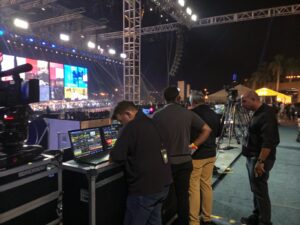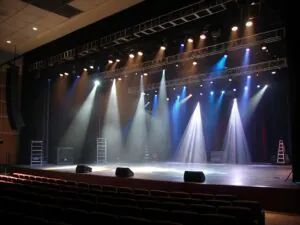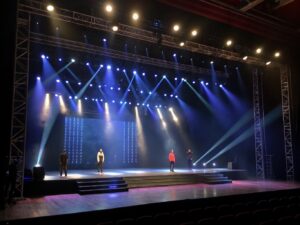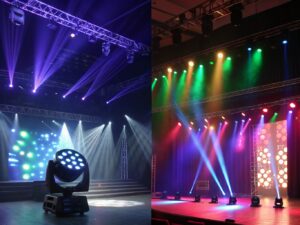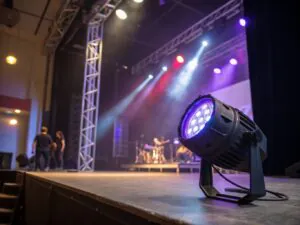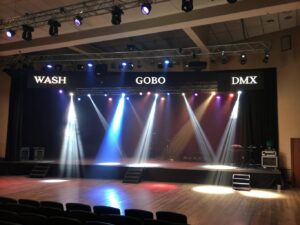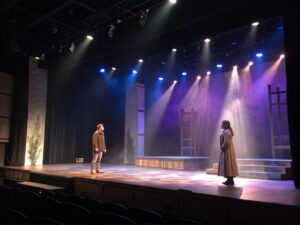
What Should You Look for in a Professional Moving Head Wash Light
Your stage lighting feels static and lifeless. You crave dynamic, vibrant color that can move with the performance, but reprogramming fixed PAR cans for every scene is slow and limits your creativity.
Look for a powerful LED engine with excellent color mixing1, a versatile zoom range to cover any area, smooth and quiet motors for professional operation, and rugged construction. These features guarantee reliability and creative flexibility for any show.

I've been in this industry for 19 years, and I’ve seen the evolution from heavy, static rigs to the dynamic lighting plots we use today. The moving head wash was a true revolution. My philosophy of "quality is life, innovation is soul" is perfectly embodied in these fixtures. The "innovation" is the LED engine and the robotics that give us incredible creative freedom. The "quality" is the silent motors2 and reliable construction that ensure the fixture works perfectly, night after night. As your partner in light, I want to help you understand how to choose a tool you can build a career on.
What Truly Makes a Moving Head Light "Professional"?
You bought some budget moving heads, but they're noisy, the movement is jerky, and the colors look washed out under pressure. They feel more like temporary toys than permanent, professional tools.
A professional moving head is defined by its reliability and performance under stress. This means near-silent motors for theatrical use, smooth 16-bit dimming curves, superior optics, and high-quality components that guarantee consistent operation every single time.

The difference between a professional fixture and a hobbyist one becomes clear on the second night of the show. For a technician like Nick in Argentina, a light that fails, makes noise, or flickers during a quiet scene is a complete disaster. "Quality is life" isn't just a slogan; it's the barrier between a flawless show and a catastrophic failure. Professional lights are an investment in peace of mind. They are engineered from the ground up to be forgotten about once they're rigged—you can simply trust them to work. The dimming is smooth, the color is repeatable, and the motors are silent. That's not a luxury; for a pro, it's the absolute minimum requirement.
Hobbyist vs. Professional Grade: What's the Difference?
| Feature | Hobbyist / DJ Grade | Professional / Touring Grade |
|---|---|---|
| Motors | Noisy, 8-bit, often jerky movement. | Whisper-quiet, 16-bit, for smooth and precise positioning. |
| Optics | Basic plastic lenses, uneven color mixing. | High-quality glass optics, homogenous beam, excellent color blending. |
| Dimming | Steppy, noticeable jumps from 0-100%. Can flicker on camera. | Smooth, flicker-free dimming curve that looks natural to the eye and camera. |
| Build & Support | Plastic housing, limited support. Built to be replaced. | Metal and robust composite housing, factory support. Built to be repaired. |
Why are LED Engines the Standard for Moving Head Washes?
Your old discharge-lamp moving heads are power-hungry, get incredibly hot, and you're constantly spending money on expensive replacement lamps. It feels like you're fighting outdated technology just to keep the lights on.
LED engines are the standard because they offer brilliant color mixing, a 20,000+ hour lifespan, low power consumption, and instant color changes. They are more reliable, cost-effective, and creatively flexible than old discharge lamp technology.

This is where "innovation is soul" truly shines. I clearly remember the days of heavy fixtures with mechanical color-scrolling wheels and discharge lamps that took minutes to warm up. An LED moving head wash completely changed the game. The ability to snap between a deep red and a vibrant blue instantly, without any moving parts for color, opened up a new world of design. For a production house, the benefits are huge. You eliminate the cost of replacement lamps and dramatically reduce your power bill. For an experienced designer, the creative upside is even bigger. You can design faster, more dynamic shows and stop worrying about your lamp's remaining lifespan. This single innovation made our rigs lighter, cheaper to run, and infinitely more creative.
The LED Advantage Over Discharge Lamps
- Long Lifespan: An LED engine is rated for 20,000 hours or more. A discharge lamp lasts for 750-2,000 hours.
- Rich Color: RGBW or RGBAW LED engines can create millions of colors instantly. Lamps required noisy, slow, mechanical CMY flags or color wheels.
- Efficiency: LEDs use far less power and produce very little heat, reducing the need for heavy cooling and high-amperage circuits.
- Durability: As a solid-state light source, LEDs are much more resistant to the bumps and vibrations of touring.
What Features Separate the Best Moving Head Washes from the Rest?
You're comparing spec sheets for different moving head washes, but the lists of features are long and confusing. You don't know which specs actually matter for creating a great-looking show.
The best moving head washes are separated by a wide and smooth zoom range3, high Color Rendering Index (CRI)4 for natural tones, and options for advanced control like individual pixel mapping for creating eye-catching effects.

Once you get past the basic requirement of a reliable build, these are the features that unlock your creativity. A wide zoom is probably the most important. A fixture that can go from a tight 4-degree beam to a wide 60-degree flood is like having two or three different lights in one. You can use it as a tight backlight for a single performer and then instantly widen it to wash the entire stage for the next scene. Color quality, measured by CRI, is also crucial. A low-CRI light might make a beautiful red dress look brown and wash out skin tones. A high CRI ensures colors look rich and natural, just as the costume and scenic designers intended. These are the details that elevate a good show to a great one.
Key Features to Look For
| Feature | What It Means for You |
|---|---|
| Wide Zoom Range | The fixture becomes incredibly versatile. Use one light for tight highlighting and broad stage washes. |
| Color Quality (High CRI) | Colors appear natural and true. Skin tones look healthy, and costumes render accurately under the light. |
| Motor Speed & Precision | The head can move fast for high-energy looks but also be slow and precise for subtle theatrical cues. |
| Pixel Control | The LED engine is divided into individually controllable zones, allowing you to create dynamic patterns and "eye candy" effects. |
How Do DJ Moving Heads Differ from Professional Lights?
You see inexpensive DJ moving heads for sale online and they look tempting. Can you save money by using these smaller lights for a theatre production5 or a corporate event?
DJ moving heads are built for portability, sound-activated modes, and affordability. Professional lights prioritize durability, quiet operation, optical quality, and precise DMX control needed for complex, pre-programmed shows. They are entirely different tools.

Using a DJ light in a professional setting is a recipe for failure. It's not because DJ lights are "bad"—they are great for their intended purpose. But their purpose is different. They are designed to be seen, to create easy "eye candy" at a party. The motors and fans are loud, which would be completely unacceptable in a quiet theatre. Their optics are simple because their job is to create a moving beam, not to light a performer with a high-quality, even field of light. As a manufacturer, we build different tools for different jobs. Trying to use a hammer as a screwdriver is frustrating and ineffective. The same is true here. A technician like Nick would never risk a show on a fixture not purpose-built for the rigors and demands of a professional environment.
DJ vs. Professional: A Head-to-Head Comparison
| Aspect | DJ Moving Head | Professional Moving Head |
|---|---|---|
| Primary Goal | Create dynamic, sound-activated "eye candy" effects. | Serve as a precise, reliable tool in a larger lighting design. |
| Operating Noise | Loud fans and motors are common and accepted. | Must be whisper-quiet for theatre and broadcast applications. |
| Build Material | Lightweight plastic to prioritize portability. | Robust metal and composites to prioritize durability and heat dissipation. |
| Control | Simple DMX modes and onboard sound-activation. | Extensive DMX profiles for granular control over every parameter. |
Conclusion
Choosing the right moving head wash means prioritizing a quality LED engine, a wide zoom, and quiet, reliable motors. This ensures you have a versatile and professional tool for any stage design.
-
Learn about the importance of color mixing for creating dynamic and vibrant stage effects. ↩
-
Understand the necessity of quiet operation for theatrical performances and broadcasts. ↩
-
Discover how a versatile zoom range can transform your lighting design capabilities. ↩
-
Discover how CRI affects the appearance of colors and skin tones under stage lights. ↩
-
Explore the role of advanced lighting in elevating the quality of theatrical performances. ↩
You may also be interested in:
